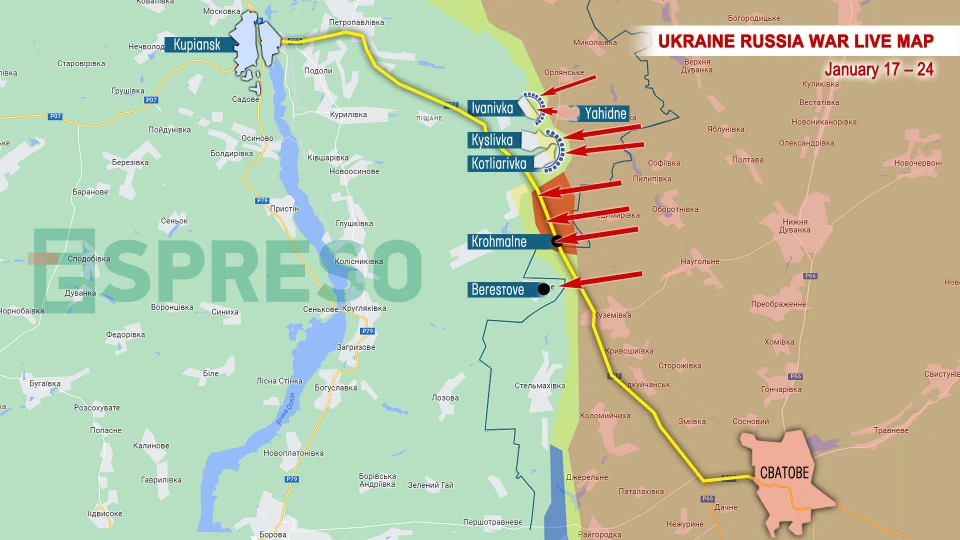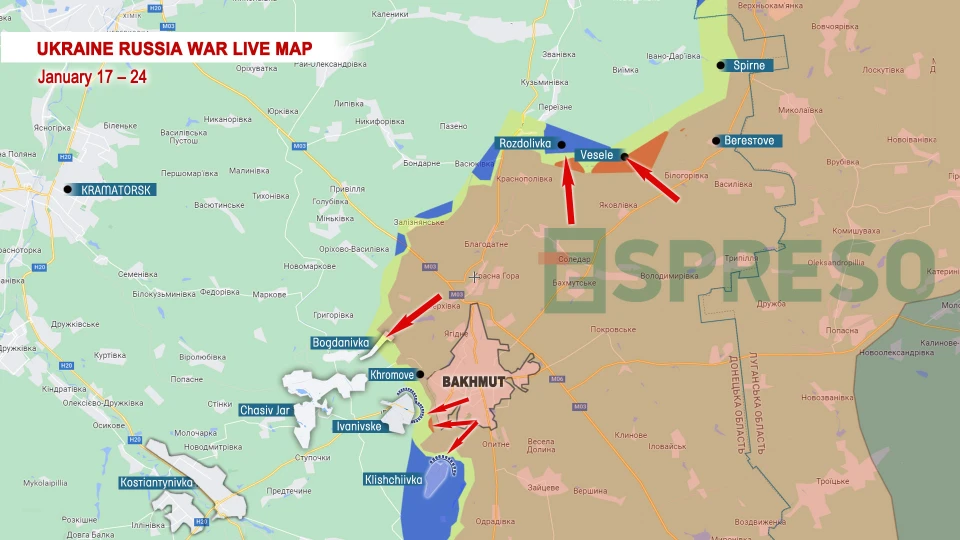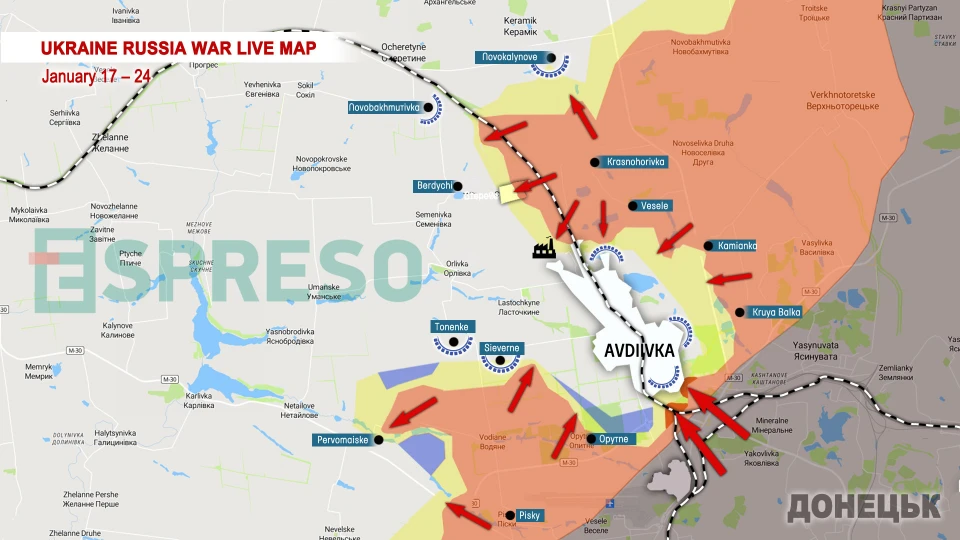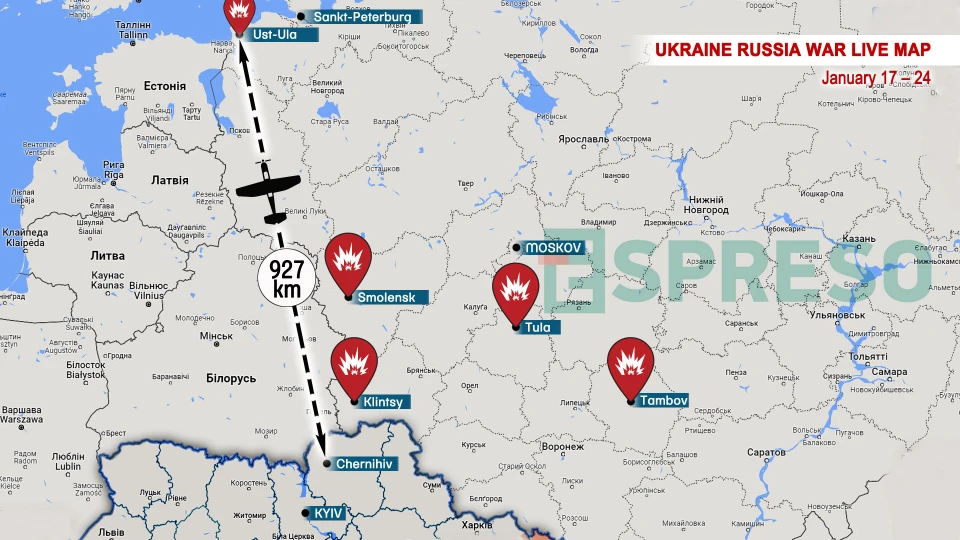
January 17-24 live war map: Russia launches third offensive phase, Ukrainian Army has new long-range weapons
Svatove and Kreminna in Luhansk region, as well as Avdiivka and Bakhmut in Donetsk region, became the epicenter of the heaviest fighting
Luhansk region: Russian troops are looking for new gaps in Ukrainian defense
For the first time in several months, invaders managed to breach a front segment of approximately 10 square kilometers between Svatove and Kupyansk, as well as enter the long-abandoned village of Krokhmalne. They also succeeded in occupying around 8 kilometers of a strategically important highway connecting Kupyansk to Svatove. Active combat operations are ongoing between the villages of Ivanivka and Yahidne. Russian forces continue their assault on Kyslivka and Kotliarivka, attempting to build on their success. However, the leadership of the Armed Forces of Ukraine assures that the situation has been successfully stabilized. Further south, in the Kreminna area, Ukrainian forces managed to repel all Russian attacks.

Bakhmut front map for the week
In this area, the trends of the previous period persist, when the invaders tried to simultaneously advance both in the northern direction, towards Siversk, and in the south, towards Chasovyi Yar. In the north, they have effectively captured the village of Vesele. Several of its northern streets remain in the grey area, but the village center and its eastern outskirts are now under occupation. Meanwhile, the Ukrainian Armed Forces have slightly improved their positions to the west of Vesele and continue to deter the Russian forces’ advance towards Rozdolivka.
To the south of Bakhmut, the situation around Klishchiivka remains unchanged. However, Russian airborne forces are vigorously advancing towards Ivanivske. Over the week, they managed to break through several hundred meters south of the Bakhmut-Chasiv Yar road and expand the grey zone to the north of Klishchiivka. At this stage, the invading Russian army's objective is to create a threat of encircling Klishchiivka, cutting off supply routes, and forcing Ukrainian defenders to retreat from strategically advantageous heights reclaimed by the Ukrainian Armed Forces in the summer.

Avdiivka holds perimeter defense
The past week has been quite challenging. Russian troops consistently targeted the city with guided airstrikes. On January 17-18, approximately a hundred such bombs fell on Avdiivka. In the Stepanove area, Russian troops made numerous attempts to establish control over the village, but the Ukrainian Defense Forces successfully repelled them each time, inflicting significant losses on the enemy.
However, at the southern gates of the city, the Russian forces managed to push back Ukrainian defenders in certain areas. The invading Russian army advanced west of the Vynohradnyky cottage settlement. Fierce battles took place in the residential sector and near the recreational complex Tsarska Okhota, which eventually fell under occupation. Russian forces also attempted to establish control in the area with single-story buildings, particularly on Sportyvna, Chernyshevskyi, and Soborna streets, but Ukrainian forces successfully ousted them from those positions. Despite the Russian troops’ occupation of some positions on the southern outskirts of the city, the situation is not critical, and the city defense remains robust.

In other frontline areas, including Kurakhove, Vuhledar, Berdiansk and Tokmak, the frontline remained unchanged despite active fighting.
Ukrainian Armed Forces have new weapons to strike at Russia, counteroffensive map
Ukraine has conducted a series of successful drone attacks deep within Russian territory, aiming to expand the battlefield and inflict significant blows that would impact both the course of the war and the aggressor country's economy. On January 18, the Security Service of Ukraine (SBU) made the first attempt to target objects in the Leningrad Oblast, but without the desired outcome. However, just three days later, Ukrainian drones hit a maritime terminal 150 km from St. Petersburg. As a result, the Ust-Luga Oil terminal, responsible for exporting 20% of Russian oil, completely ceased operations for two days. Even after extinguishing the fire, the terminal will be unable to function fully for approximately a month.
A crucial aspect of this attack is the introduction of drones by the Ukrainian Armed Forces capable of flying over 1000 km and carrying more explosives than their predecessors. Consequently, the rear areas of the adversary have become vulnerable, as they were not previously covered by effective air defense systems, especially from the southern direction. Despite the deployment of air defense systems in St. Petersburg after the strike, they may not be sufficient to cover all military and industrial strategic targets within a 1000 km range. As a result, the Russian Federation will be compelled to reassess and redistribute its resources.
 Meanwhile, en route to St. Petersburg, Ukrainian drones managed to reach Smolensk, where they struck an aircraft repair plant producing various modifications of the Kh-59 missile. Additionally, explosions occurred at the military plant Shcheglivsky Val in Tula, responsible for manufacturing components for air defense systems, specifically the Pantsir-S1 missile system. Another drone targeted the Tambov Powder Plant. Although this attack did not lead to extensive destruction, the target is now under close scrutiny.
Meanwhile, en route to St. Petersburg, Ukrainian drones managed to reach Smolensk, where they struck an aircraft repair plant producing various modifications of the Kh-59 missile. Additionally, explosions occurred at the military plant Shcheglivsky Val in Tula, responsible for manufacturing components for air defense systems, specifically the Pantsir-S1 missile system. Another drone targeted the Tambov Powder Plant. Although this attack did not lead to extensive destruction, the target is now under close scrutiny.
For several days in a row, one of the most powerful fires since the beginning of the full-scale war has raged at an oil depot in the city of Klintsy in the Bryansk region. There are hundreds of such vulnerable facilities, which serve as the lifeblood of the Russian military and are within reach of the new drones.
Missile strike results
Russian terrorists carried out their fifth mass rocket strike within a month, this time deploying even fewer rockets – a total of 43, all targeting exclusively civilian objects. Ukrainian air defense systems successfully intercepted all 15 cruise missiles (Kh-101/Kh-555/Kh-55) over Kyiv region, along with 5 out of 12 ballistic missiles Iskander, and one guided Kh-59 missile. Unfortunately, the remaining 15 ballistic missiles (Kh-22, Iskander) and one Kh-59 missile hit residential areas in Kharkiv and Pavlohrad. The latest round of attacks demonstrated that Russia's missile resources are gradually depleting, especially concerning cruise missiles. However, the absence of adequate air defense in the eastern regions still provides Russian forces with the capability to terrorize using ballistic missiles.
- News













































